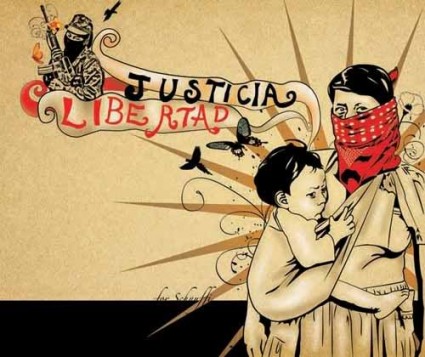Zapatistas: the wealth of dignity
December 2013
On the 20th anniversary of the Zapatista uprising of 1st January 1994 we publish this article by Luis Hernández Navarro which illustrates the achievements of Zapatista autonomy. Thanks to Dorset Chiapas Solidarity.
In the community of Emiliano Zapata in the caracol Whirlwind of Our Words, 30 Zapatista families work collectively. They have in common a coffee plantation, vegetable gardens and about 350 head of cattle. Its inhabitants do not receive government support of any kind, but their standard of living is much better than that of the surrounding PRI-governed settlements.
In the community there is a small cooperative shop whose proceeds go to works that people need. There, as in all the other rebel regions, the cooperative’s resources are used to finance public works such as schools, hospitals, clinics, libraries or water pipes.
Throughout all the rebel territory, an autonomous system of well-being flourishes, based on a de facto land reform which prioritises the communal use of the lands and natural resources in collective work, as well as in the production of items for use, and fair trade practices in the international market.
In areas of Zapatista influence, they have been overthrowing the law of San Garabato [greed], which dictates that farmers must buy the goods they need at high prices and sell their products cheaply. It happens frequently that coyotes (abusive commercial intermediaries) find themselves forced to pay the rebel support bases higher prices for their crops, livestock and crafts than those offered to the residents who are not organised. The Zapatista cooperatives have acquired a veritable swarm of motor vehicles for moving and transporting their products.
In the rebel communities, an environmental awareness has also been developed. There agroecology is practiced and the use of chemical fertilizers has been banished. Work is done to protect the soil. There is a genuine and widespread concern for conserving forests and jungles.
As the authors of the book “Very Other Struggles (Luchas muy Otras): Zapatismo and Autonomy in the Indigenous Communities of Chiapas”, say: “the challenges of sustainability in community production highlight the tension between the need to survive within the existing socioeconomic scheme and the project to transform that scheme.” What emerges here is, rather than a Zapatista economic model, “an endogenous and diverse process of prioritising the communities as an alternative to submitting to the steamroller logic of transnational capital.”
In the 27 Zapatista municipalities, alcohol is not drunk and drugs are not grown. Justice is exercised without government intervention. Rather than punishment, the focus is put on the rehabilitation of the offender. Women have taken positions and responsibilities which they undertake infrequently in rural communities.
The network of common infrastructure in education, health, agro-ecology, justice and self-government, which the insurgents have built outside State institutions, functions according to its own logic, which is plural and diverse. The Zapatista communities have trained hundreds of education and health promoters and agricultural technicians, in accordance with their own culture and identity.
All this has been achieved because the Zapatistas govern themselves and defend themselves. They have constructed their autonomy without asking permission, in the midst of an ongoing counterinsurgency campaign. They resist continual harassment from 51 military bases and from welfare programmes which seek to divide the communities in resistance by offering them crumbs.
However, towards the end of this year a smear campaign was unleashed which asserts that none of this is true. Falsely, it claims that the Zapatistas are worse off today than they were 20 years ago, that they are destroying the environment and dividing communities. This is the latest episode in a dirty war as old as the uprising itself.
The slanders do not hold up. Hundreds of public testimonies demonstrate that the accusations against the rebels have nothing to do with the reality that the slanderers spread. For example, the painter Antonio Ortiz, Gritón, was in the community of Emiliano Zapata between 11th and 16th August this year, as part of the Zapatista escuelita, and documented his experience in a moving account that he put on Facebook. He was surprised to find that 30 indigenous families owned 350 head of cattle. He was part of a group of 1,700 people who attended the first Zapatista escuelita that month. …more

Comments are closed.